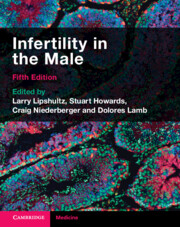Book contents
- Infertility in the Male
- Infertility in the Male
- Copyright page
- Contents
- Contributors
- Foreword
- Abbreviations
- Introduction
- Section 1 Scientific Foundations of Male Infertility
- Section 2 Clinical Evaluation of the Infertile Male
- Section 3 Laboratory Diagnosis of Male Infertility
- Section 4 Treatment of Male Infertility
- Chapter 21 Medical Treatment of Male Infertility
- Chapter 22 Surgery to Improve Sperm Delivery
- Chapter 23 Sperm Retrieval Surgery
- Chapter 24 The Use of Sperm in Medically Assisted Reproduction
- Chapter 25 Male Oncofertility – Considerations for Fertility Preservation and Restoration
- Chapter 26 Male Contraception
- Chapter 27 Future Directions in Male Infertility
- Section 5 Health Care Systems and Culture
- Index
- References
Chapter 27 - Future Directions in Male Infertility
from Section 4 - Treatment of Male Infertility
Published online by Cambridge University Press: 08 July 2023
- Infertility in the Male
- Infertility in the Male
- Copyright page
- Contents
- Contributors
- Foreword
- Abbreviations
- Introduction
- Section 1 Scientific Foundations of Male Infertility
- Section 2 Clinical Evaluation of the Infertile Male
- Section 3 Laboratory Diagnosis of Male Infertility
- Section 4 Treatment of Male Infertility
- Chapter 21 Medical Treatment of Male Infertility
- Chapter 22 Surgery to Improve Sperm Delivery
- Chapter 23 Sperm Retrieval Surgery
- Chapter 24 The Use of Sperm in Medically Assisted Reproduction
- Chapter 25 Male Oncofertility – Considerations for Fertility Preservation and Restoration
- Chapter 26 Male Contraception
- Chapter 27 Future Directions in Male Infertility
- Section 5 Health Care Systems and Culture
- Index
- References
Summary
Since the first live births reported using intracytoplasmic sperm injection (ICSI), ICSI has become the mainstay of treatment for male factor infertility. Given the ability to inject a single spermatozoon into the cytoplasm of the oocyte, ICSI bypasses the zona pellucida and allows for fertilization and embryo development, independent of sperm parameters. ICSI is utilized in the majority of all assisted reproductive technology (ART) treatments worldwide and has led to the birth of millions of children. Although a highly useful tool, ICSI has led to a substantial decline in advances in male infertility as it has been garnered a “treatment” for male factor infertility [1]. A 9-year retrospective single-institution study found a cause for male infertility in only approximately 40 percent of cases among 1737 patients with oligozoospermia, representing 86.3 percent of idiopathic infertility patients [2]. As such, further studies are required to identify etiologies and potential treatment options for idiopathic male infertility. Furthermore, ICSI has not been shown to be superior to conventional in vitro fertilization (IVF) in cases of nonmale factor infertility; yet it is the most commonly used modality for ART [3]. It can be argued that by using ICSI, we further limit the process of natural selection as we are choosing which sperm bypasses the natural barriers. The long-term outcomes of ICSI are still unknown. Nonetheless, IVF and ICSI are two of the greatest technological medical advancements and has offered millions of couples the ability to conceive a child. Herein, we provide a review of novel and exciting advances in the field of male reproductive urology.
- Type
- Chapter
- Information
- Infertility in the Male , pp. 495 - 502Publisher: Cambridge University PressPrint publication year: 2023



